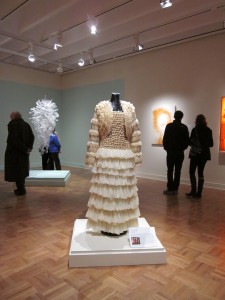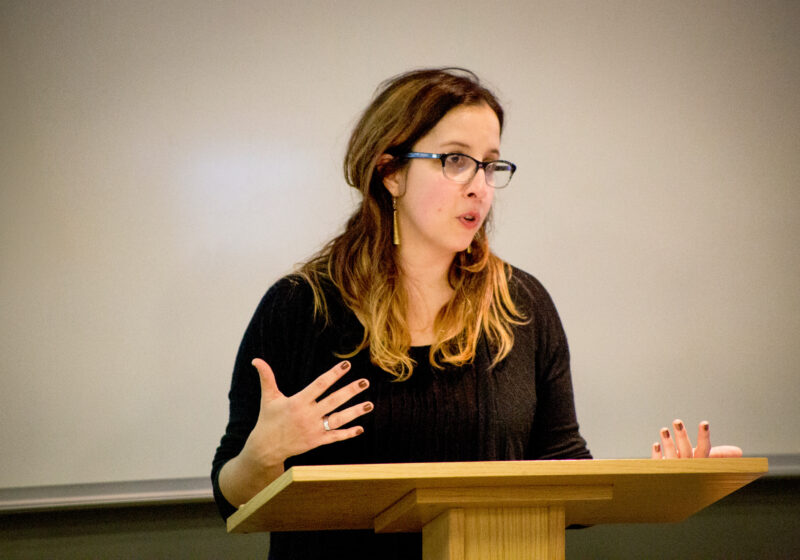
Courtesy of Julia Sklar - A&E Editor
“A found object is just a familiar thing seen as though for the first time,” artist Nemo Gould said about the peculiar medium of the Memorial Art Gallery’s newest exhibit “Extreme Materials 2” that opened on Saturday, Oct. 22.
The exhibit is a rehash of the MAG’s original one — “Extreme Materials” — from 2006, which showcased art made from some of the most unexpected materials imagineable. The art show garnered so much praise and so many visitors — about 28,000 attendees over the course of 10 weeks — that the museum finally bowed to the outside pressures that begged for them to run another show of found art.
“Our hope is that at least one involuntary ‘wow’ escapes your lips today,” Director of Exhibitions Marie Via wrote in an introductory letter about the exhibit.
While this sounds like a vague and cliché plea for patrons to appreciate the exhibit’s artwork, it was actually astonishing how quickly involuntarily gasps of amazement escaped from viewers — myself included. “Extreme Materials 2” had the distinct ability to create what was without a doubt the loudest room in a museum I have ever been to, as nobody could stifle their admiration.
People were dashing from piece to piece in an awestruck frenzy, impatiently pulling their friends and family by the sleeves to show them yet another outstanding aspect to the exhibit or striking up excited conversations with complete strangers, joining in their mutual appreciation of this completely one-of-a-kind art.
Take, for example, the very first piece on display when you walk into the exhibit. Rosemarie Fiore’s “Firework Drawing #9” is a large canvas made of Fabriano paper that immortalizes lit firework residue. She made this effect by trapping lit fireworks under metal cans and pushing them around the paper or attaching the firework to a stick and dragging it. The result is an attack of vibrant colors, dancing and sparkling across the paper, described by Fiore as “a physical record of the life and death of an explosion.” In this case, the astonishing factor isn’t the look of the art itself, but rather the method used to make it.
Similarly, Phyllis Hackelman’s six framed pieces captured viewers’ amazement because of their back-story more than their outward appearance. They say necessity is the mother of invention and Hackelman’s work holds true to that maxim. When Kodak closed her darkroom due to financial instability, Hackelman turned to another way of producing photographs: printing them with an ink jet printer on used coffee filters. The result is something that vaguely retains its photographic origins but looks more like a Japanese watercolor. Many people came and looked at her art, read her story and then did a double-take back to the pictures.
While there was no prerequisite theme that artists had to stick to, one emerged on its own. The beauty of art is that it is frequently able to synthesize the common worries of a society. In this case, many of the pieces are inspired by anxiety over the earth’s current environmental condition as well as vapid consumerism.
Perhaps the singular best fusion of these two concepts is in “The Wave” by Tom Deininger. This 3-D work is, from afar, an ocean wave crashing down on itself as the sun glints down on it. Up close, however, you can see that the wave is built out of a potpourri of a materialistic society’s discarded remnants. Pens, hairbrushes, hangers, Furbies, toy racecars, stilettos, plastic forks — literally any odd or end you can think of — swirl around in shades of blue and yellow as an unnervingly not-so-hyperbolic representation of the consumerist waste that fills the ocean.
Not all of the featured art is truly inspirational, however. Some of it is just downright disgusting. “Corpus Regis” by Jess von der Ahe is a replica of a portrait of King Ludwig II of Bavaria painted entirely with her own menstrual blood. While many of the viewers got up close and personal by inspecting the intriguing art on display in “Extreme Materials 2,” this was one piece that everyone stayed a good five feet away from after reading the explanatory panel that accompanied the painting.
Around the corner is “Tampon Cake” by Vadis Turner, which, as the name suggests, depicts a wedding cake that is built from unused tampons. The least the curators could have done to
make these two pieces a little less weird and a little funnier would have been to put them next to each other in the exhibit.
Nevertheless, there is an impressive amount of breadth present in the types of pieces featured — many are done on canvases or wood and are hanging on the wall, but there are also plenty of installation pieces and even a fair amount of fashion.
Two such fashion pieces that I found particularly interesting were “Gabrielle” by Adriana Bertini and “Negligee #2 (Serotonin)” by Laura Splan. “Gabrielle” is a dress and matching jacket made out of condoms that mimics a Chanel design. This piece was inspired by Bertini’s extensive work with HIV/AIDS positive children in Brazil, and the 2,920 condoms used to construct the dress were ones that had failed quality control tests.
Splan’s fashion piece was made from cosmetic facial peel that she covered her body in and then peeled off in large enough sheets to sew a dainty nightgown. The chemical compound machine-embroidered into the “fabric” multiple times was serotonin, a neurotransmitter that is active during sleep and sex.
Two of the most intricate pieces on display are “Fortune’s Daughter” by Mark Wagner and “Organized Knowledge in Story and Picture” by Brian Dettmer.
“Fortune’s Daughter” is a large-scale picture of a woman in the anatomical position, strikingly made entirely out of one dollar bills. Wagner only spent $200 making this — but he could probably charge $1,000 or more to sell it — and inventively built a 2-D woman from cutting and pasting together 12,390 different curves, corners, flowers and other minute designs I personally never even noticed were present on a dollar.
This is definitely worth inspecting in detail for a couple minutes, as there are many fine intricacies hidden in the picture. For example, Wagner took the Federal Reserve bank letter “L” that can be found on the front of some dollars and put this in the middle of the woman’s left hand and cut the bottom off the Federal Reserve bank letter “B” to make an “R” and put that in the middle of her right hand.
Dettmer’s piece also necessitates minute inspection. “Organized Knowledge” is constructed of old encyclopedias that Dettmer “excavated.” He essentially sat down with an exacto knife and cut away at the pages one by one in order to see what images he could unearth as he went, ending up with a 3-D book full of continents, historical figures, words and technological devices that you feel like you’re falling into as you look at his piece.
“Extreme Materials 2” was the most exciting and inspirational art exhibit I’ve ever been to, and I think even people who normally wouldn’t be caught dead in an art museum would enjoy spending an hour or two at this exhibit.
The MAG is easily accessible via the Red Line bus, and entrance is completely free for UR students. In other words, there are no reasons why any person on this campus shouldn’t go see “Extreme Materials 2” at least once, or maybe even twice, between now until when it closes on Jan. 15, 2012.
Sklar is a member of the class of 2014.


